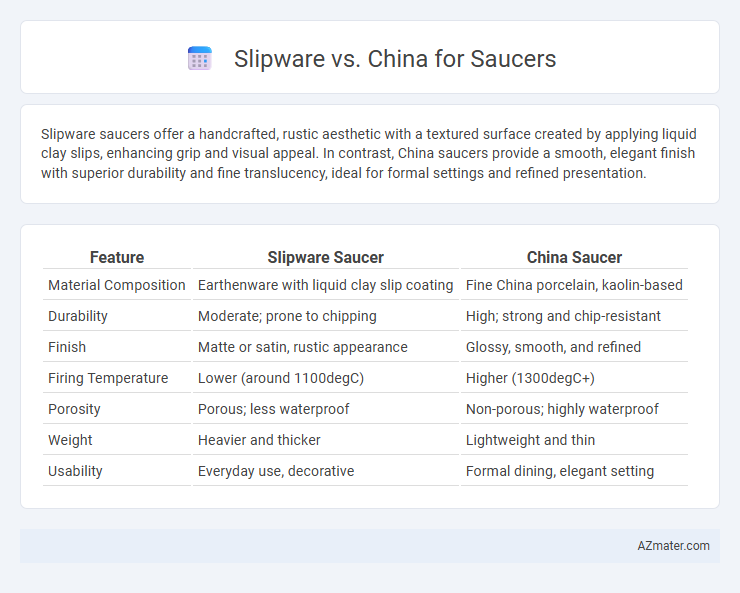Slipware saucers offer a handcrafted, rustic aesthetic with a textured surface created by applying liquid clay slips, enhancing grip and visual appeal. In contrast, China saucers provide a smooth, elegant finish with superior durability and fine translucency, ideal for formal settings and refined presentation.
Table of Comparison
| Feature | Slipware Saucer | China Saucer |
|---|---|---|
| Material Composition | Earthenware with liquid clay slip coating | Fine China porcelain, kaolin-based |
| Durability | Moderate; prone to chipping | High; strong and chip-resistant |
| Finish | Matte or satin, rustic appearance | Glossy, smooth, and refined |
| Firing Temperature | Lower (around 1100degC) | Higher (1300degC+) |
| Porosity | Porous; less waterproof | Non-porous; highly waterproof |
| Weight | Heavier and thicker | Lightweight and thin |
| Usability | Everyday use, decorative | Formal dining, elegant setting |
Introduction to Slipware and China Saucers
Slipware saucers, characterized by their rich, hand-applied slip decoration, offer a rustic and artisanal appearance with unique glazing effects achieved by layering liquid clay mixtures. China saucers, typically made from fine porcelain, provide a smooth, durable surface with high translucency and elegant, market-preferred finishes often enhanced by vitreous glazing. The contrast between the tactile, earthy aesthetics of slipware and the refined, classic beauty of china makes each material distinct in terms of craftsmanship and visual appeal for saucers.
Historical Origins of Slipware and China
Slipware, a type of pottery decorated with liquid clay slip, originated in ancient Mesopotamia and gained prominence during the medieval period in Europe for its distinctive painted designs. China, or porcelain, was first developed during the Tang Dynasty (618-907 AD) and perfected in the Song Dynasty, prized for its translucent quality and durability. While slipware showcases hand-crafted artistry rooted in early utilitarian ceramics, China represents a sophisticated, high-fired ceramic tradition with refined aesthetics and technological innovation.
Material Composition Differences
Slipware saucers are crafted from earthenware clay decorated with a liquid clay slip that creates a textured, often rustic surface, containing high levels of silica and alumina but lower vitrification compared to china. China saucers, made from fine porcelain composed primarily of kaolin, petuntse, and feldspar, offer a denser, more vitrified material with a smooth, translucent finish that resists chipping. The fundamental difference lies in slipware's porous, less refined clay body versus china's highly refined, non-porous porcelain composition, resulting in distinct durability and aesthetic qualities.
Crafting Techniques and Artistry
Slipware saucers showcase distinct craftsmanship through the use of liquid clay (slip) applied to the surface before firing, allowing intricate painted or trailed designs with a textured, earthy finish, reflecting regional folk art traditions. China saucers, typically made from refined porcelain, emphasize delicate translucency and smooth, glossy surfaces achieved through high-temperature kiln firing and precise glazing techniques, often featuring detailed transfer-printed or hand-painted motifs. The artistry in slipware conveys rustic charm and tactile appeal, whereas china highlights elegance and refined detail, both representing specialized cultural ceramic techniques for functional tableware.
Aesthetic Appeal and Decorative Styles
Slipware saucers feature a rustic, hand-crafted aesthetic characterized by rich textures and earthy glazes, often highlighting folk art motifs and traditional slip-trailed patterns. China saucers display a refined elegance with smooth, translucent surfaces and intricate decor such as delicate floral designs, gilded accents, and precise, symmetrical patterns. The decorative styles of slipware prioritize organic, tactile qualities, while china emphasizes polished sophistication and detailed artistry.
Durability and Everyday Use Comparison
Slipware saucers exhibit exceptional durability due to their thick, hand-crafted clay body with a lead-free glaze that resists chipping and everyday wear, making them ideal for frequent use. In contrast, fine china saucers, while elegant and lightweight, tend to be more fragile and prone to cracks or chips, requiring careful handling during daily use. For durability and practicality in everyday settings, slipware saucers outperform china with their robust construction and resilience.
Functional Benefits of Each Type
Slipware saucers offer excellent durability and resistance to chipping due to their thick slip-coated surface, making them ideal for everyday use and high-traffic settings. China saucers provide superior heat retention and a smooth, non-porous surface that enhances the flavor experience and ease of cleaning, suitable for formal dining. Both materials deliver reliable support for cups but differ in their functional benefits related to durability versus aesthetic and tactile refinement.
Collectibility and Market Value
Slipware saucers, characterized by their distinctive slip-coated decoration and earthy textures, often appeal to collectors valuing artisanal craftsmanship and historical authenticity. In contrast, fine China saucers, known for their delicate translucency and refined porcelain quality, command higher market value due to brand prestige and production techniques like bone china firing. Collectibility of slipware is niche yet growing, while China saucers maintain strong demand and consistently perform well in auction markets.
Care and Maintenance Requirements
Slipware saucers require gentle hand washing with mild soap to preserve their distinctive textured glaze, avoiding abrasive scrubbers that can damage the surface. China saucers are more durable for everyday use and can typically withstand dishwasher cleaning, but delicate patterns may fade over time if exposed to harsh detergents. Proper storage for both types involves stacking with protective padding to prevent chipping and preserve their aesthetic appeal.
Choosing the Right Saucer for Your Table
Slipware saucers showcase rustic charm with their hand-painted designs and tactile textures, ideal for adding artisanal warmth to casual dining settings. China saucers, crafted from fine porcelain, offer elegant translucency and durability, perfect for formal occasions or traditional tableware collections. Selecting the right saucer depends on balancing aesthetic preferences with the intended use, where slipware enhances cozy, artistic vibes and china elevates refined, classic presentations.

Infographic: Slipware vs China for Saucer
 azmater.com
azmater.com